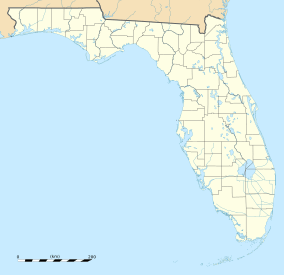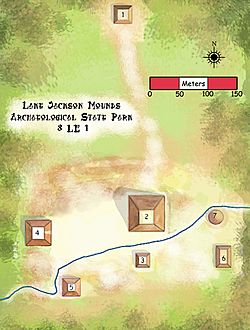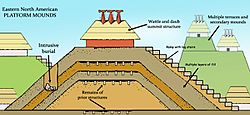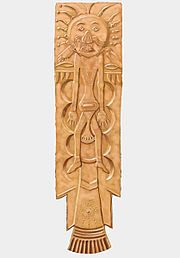Lake Jackson Mounds Archaeological State Park facts for kids
Quick facts for kids Lake Jackson Mounds Archaeological State Park |
|
|---|---|

Mound 2, the largest earthwork at the site
|
|
| Location | Leon County, Florida, USA |
| Nearest city | Tallahassee, Florida |
| Established | May 6, 1971 |
| Governing body | Florida Department of Environmental Protection |
Lake Jackson Mounds Archaeological State Park is a very important place in Florida. It was once the main city and special center for a group of people called the Fort Walton Culture. They lived here from about 1050 to 1500. This ancient city had seven large earthwork mounds, a big open area called a plaza, and many homes.
This park is one of several big mound sites in the Florida Panhandle. You can find it in northern Tallahassee, right on the south shore of Lake Jackson. The site has been a Florida State Park since 1966. It was added to the U.S. National Register of Historic Places on May 6, 1971, which means it's a very special historical place.
Contents
Fort Walton Culture: Who Lived Here?
The people of the Fort Walton culture built and lived at this site between 1000 and 1500. They were part of a larger group known as the Mississippian culture, which lived across the southeastern United States. The huge size of the site and its many large mounds tell us that this was the center of a powerful chiefdom. A chiefdom was like a small kingdom, with a main leader (a chief) who controlled many villages. This site was important for both politics and religion.
After people left the Lake Jackson site, the main chiefdom moved to a place called Anhaica. In 1539, the explorer Hernando de Soto visited Anhaica. He met the people living there, who were known as the Muskogean-speaking Apalachee people. Other places where Fort Walton people lived include Velda Mound and Yon Mound and Village Site.
What the Site Looked Like
When the site was left behind, it was a large complex, about 47 acres in size. It had seven platform mounds. Six of these mounds were placed around a central plaza, and a seventh mound (Mound 1) was about 820 feet to the north. These mounds were not just piles of dirt. They were carefully planned and built over many years by many workers.
The ceremonial plaza was a big, flat area. It was made level on purpose for special games and gatherings. Around the mounds and plaza, there were areas where many people lived. These were homes for artists and workers. In the countryside nearby, people grew maize (corn) in the rich soil. This good farming land helped a large population live here. Only a few of the mounds in the park have been carefully studied by archaeologists.
The whole site is lined up from east to west. This matches the direction of the Meginnis Arm, a part of Lake Jackson nearby. All the mounds are also lined up this way. We don't know if this was for a special reason or just because of the lake's shape.
How the Site Grew Over Time
Archaeologists have learned that the site grew in different stages:
- Lake Jackson I phase (1050-1150): The site started as a small village. Mound 2 might have begun to be built during this time.
- Early Lake Jackson II phase (1150-1250): More people moved here, and the village areas grew a lot. Mound 5 was started, and Mound 2 continued to grow.
- Late Lake Jackson II phase (1250-1400): All seven mounds were started, and most were built up many times. Mounds 5 and 6 might have been finished. Mounds 2, 3, and 4 were still being built.
- Lake Jackson III phase (1400-1500): The main part of the site, especially around Mound 2, became very busy. Mounds 4, 5, and 6 were finished before this phase. Mounds 2 and 3 were completed during this time.
After about 1500, people mostly left the site. There is very little evidence that anyone lived here after that, though some people might have visited.
Pottery Clues: Dating the Past
Archaeologists use changes in pottery styles to figure out how old a site is and how it changed over time. The pottery found at Lake Jackson helps them understand the different periods of the site's history. Different types of pottery, like those with special designs or made with certain materials, tell archaeologists about the time they were made.
Mound 2: The Biggest Mound
Mound 2 is in the middle of the site. It's the largest and best-kept mound. It stands about 36 feet high and is about 272 feet by 312 feet at its base. Like the other mounds here, it's a simple flat-topped pyramid. Not much digging has happened at this mound, so we don't know a lot about how it was built or what buildings were on top.
In 1947, an archaeologist named John Griffin did some limited work on the mound. He found layers of different soils, but he couldn't learn much about its purpose. It was probably the first mound started at the site. If it was like mounds at other sites, it was likely the home of the main leader or chief of the area.
Mound 3: A Burial Place
Mound 3 is about 164 feet south of Mound 2, across a plaza. It's the third largest and tallest mound at the site. Mound 3 was used as a burial mound. When it was finished, it was about 16 feet high and 144 by 157 feet at its base.
Archaeologists found that the mound was built between 1190 and 1475. Before the mound was built, there was a village here. The first special activity was digging a pit and filling it with 35 stone arrowheads and burned wood. This was covered with clay, and a building was put up. This building might have been used for special feasts. Later, this building was burned, and the first layer of the mound was built over it. The first burial was placed in this layer.
The mound was built up in stages, with new layers added over time. White sand from the lake shore was often used as a first layer for each new stage. Then, mound dirt was added, and a thin layer of red clay from nearby hills was put on top. Archaeologists could see that the dirt was brought to the site in baskets, as they could still see the marks of individual basket loads.
Holes found on top of the mound show that buildings with fences (palisades) were built there. The last building on top was rectangular, about 24 by 30 feet. This shape is unusual for the Apalachee people, who usually built round homes. Archaeologists think this might be because of ideas from other Mississippian sites where rectangular buildings were common.
The cycle of burning a building, adding new dirt, capping it with clay, and building a new structure happened twelve times over 250 years. This suggests that when a leader died, their building was destroyed, and the mound was "renewed" with new layers.
Sadly, Mound 3 was on private land and was not protected like the mounds in the park. It was dug away in 1975-1976 to be used as dirt for other projects. Before it was destroyed, archaeologist B. Calvin Jones quickly saved what he could. He found 24 burials from Mound 3. Some graves were deep pits, lined with split logs. Before burial, bodies were wrapped in cloth, and a special copper plate was placed on their chest. They were then wrapped in leather and mats and placed in the pits. This way of wrapping bodies is similar to "bundling" sacred objects, a very old practice among Native Americans.
Other special items were found with the burials. In older layers, the items were simpler. In newer, higher layers, the items were more fancy. These included many objects made of copper, beads made of shell and pearl, and pipes used for smoking tobacco in rituals. Most of the burials were important men, but one woman (with the most beautiful copper plate) and a child were also found, showing they were also important.
Other Mounds: 1, 4, 5, 6, and 7
- Mound 1 was partly dug up in the 1950s. Most of the information from that work is now missing. Mound 1 is the only mound not inside the park and is still privately owned.
- Mound 4 was built between 1250 and 1400. It started with a layer of white sand, then dirt from baskets, and a red clay cap. It had several more layers added.
- Mound 5 is the smallest mound. It was built over an old village area and had at least two building stages. It seems to have been left behind during the Late Lake Jackson phase.
- Mound 6 was also built over an older village. It had a layer of light-colored sand before building began. Several layers were added over the years, and there was evidence of buildings on top. Items found here date from 1250 to 1400.
- Mound 7 has never been dug up, so we know almost nothing about it. Its shape is so worn down that it's hard to even tell for sure if it was a platform mound.
Plazas: Gathering Places
The way the mounds are arranged suggests there might have been two large plaza areas. One plaza might have been formed by Mounds 2, 3, 4, and 5. Another might have been formed by Mounds 2, 3, 6, and 7. A small stream, Butler's Mill Creek, once ran through these areas. Digging has shown that a clean area between Mounds 2 and 4 was definitely a plaza. More work is needed to confirm the other possible plaza areas.
Special Art and Connections
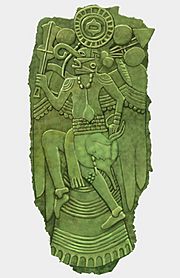
Many amazing artifacts have been found at Lake Jackson. These include copper plates (some with designs), copper headdress badges, engraved shell gorgets (necklaces), pearl beads, copper axes, and stone and ceramic pipes. Many of these items have special designs called motifs that are part of the Southeastern Ceremonial Complex (SECC). This was a shared set of beliefs and symbols among many Mississippian cultures.
Similar artifacts have been found at other big mound sites like Spiro Mounds in Oklahoma, Moundville site in Alabama, and Etowah Mounds in Georgia. The items from Lake Jackson show the closest connections to Etowah.
The burials in Mound 3 were ranked into three levels:
- Elite: Buried with the most fancy copper items, pearl beads, and clothing decorated with shark teeth.
- Middle Rank: Buried with stone axes or shell/bead necklaces.
- Low-Ranked: Had no special items.
The designs on these items changed over time, becoming more detailed. Archaeologists think this shows that ideas from other powerful groups influenced the people here. It also shows the rise of a strong warrior class. At least ten of the burials found were of "elite war leaders." The most detailed copper plate found at Mound 3 looks a lot like two famous plates found at the Etowah Site. These plates are thought to have been made at Cahokia, a very large mound center in Illinois, before being traded to sites in the Southeast.
Lake Jackson Mounds State Park Today
In May 1966, the State of Florida bought about 11.5 acres of land and named it the Lake Jackson Mounds State Archaeological Site. At that time, most of Mound 2, all of Mound 4, and about half of Mound 5 were in the park. The other mounds were still privately owned. Later, more land was bought, and by 2007, only Mound 1 remained outside the park.
Today, the park is a great place for outdoor activities. You can go hiking on its trails and enjoy picnics at the wooden tables. The park is part of the Native American Heritage Trail in Florida.
There are two main trails for hiking:
- A 0.75-mile interpretive trail that tells you about Florida's history from 1820-1860. This land was once part of a large estate owned by Colonel Robert Butler.
- A 2.2-mile nature trail that winds through native plants and trees. On this trail, you might even see an old grist mill from the 1800s.
The Florida State Parks website for Lake Jackson Mounds Archaeological State Park has lots of information, including a map you can download. Six of the seven known mounds are in the park. You can see two of the largest mounds from the picnic area. There's also a special exhibit in the pavilion that teaches visitors about the Native Americans who once lived here.
Archaeologists have been digging at the park for many years. Any artifacts they find belong to the Florida Division of Historic Resources. These items are kept in a special storage place. Artifacts found include pieces of pottery, shells, stone tools, and burial objects made of copper, mica, and other materials.
It costs a small fee to enter the park: $3 per car, or $2 for people walking or on bikes. You pay using an honor system. The park is open every day from 8:00 AM until sunset. You can enjoy birding, hiking, picnicking, and watching wildlife. If you have a group, you can book a guided tour two weeks in advance. The park has parking and restrooms, and pets are allowed if they are on a leash.
Rare Plants: A Special Discovery
The park is home to a rare and endangered plant called the Trillium reliquum. Hikers found it in February 2010. Before this, people thought this plant only grew in parts of Alabama, Georgia, and South Carolina. The U.S. Fish and Wildlife Service is now working to count and protect these plants.
See also
Images for kids


